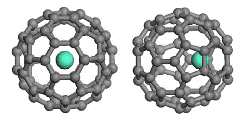Chemistry, Department of: Faculty Series

Xiao Cheng Zeng Publications
Document Type
Article
Date of this Version
2015
Citation
Nanoscale, 2016, 8, 1299–1304
DOI: 10.1039/c5nr07810e
Abstract
We have analyzed the structures of two medium-sized thiolateprotected gold nanoparticles (RS-AuNPs) Au40(SR)24 and Au52(SR)32 and identified the distinct structural features in their Au kernels [Sci. Adv., 2015, 1, e1500425]. We find that both Au kernels of the Au40(SR)24 and Au52(SR)32 nanoclusters can be classified as interpenetrating cuboctahedra. Simulated X-ray diffraction patterns of the RS-AuNPs with the cuboctahedral kernel are collected and then compared with the X-ray diffraction patterns of the RS-AuNPs of two other prevailing Au-kernels identified from previous experiments, namely the Ino-decahedral kernel and icosahedral kernel. The distinct X-ray diffraction patterns of RS-AuNPs with the three different types of Au-kernels can be utilized as signature features for future studies of structures of RS-AuNPs. Moreover, the simulated UV/Vis absorption spectra and Kohn–Sham orbital energy-level diagrams are obtained for the Au40(SR)24 and Au52(SR)32, on the basis of time-dependent density functional theory computation. The extrapolated optical bandedges of Au40(SR)24 and Au52(SR)32 are 1.1 eV and 1.25 eV, respectively. The feature peaks in the UV/Vis absorption spectra of the two clusters can be attributed to the d → sp electronic transition. Lastly, the catalytic activities of the Au40(SR)24 and Au52(SR)32 are examined using CO oxidation as a probe. Both medium-sized thiolate-protected gold clusters can serve as effective stand-alone nanocatalysts.


Comments
Used by permission.